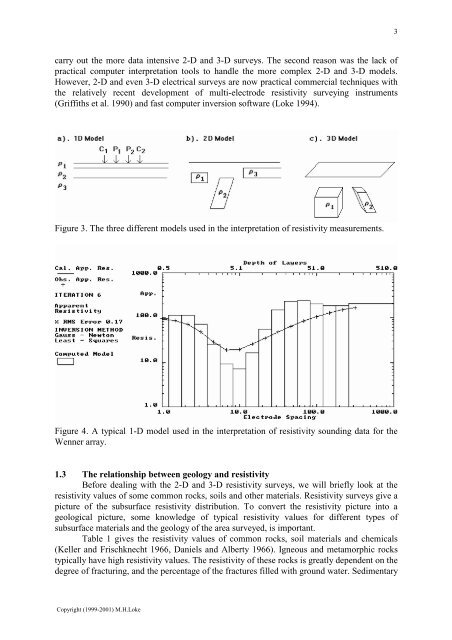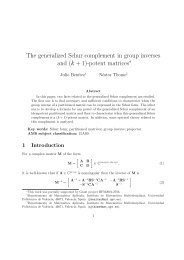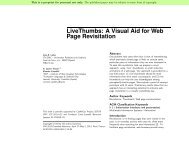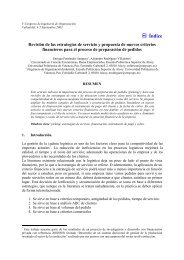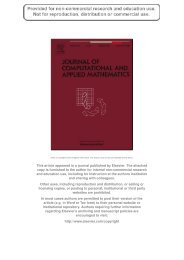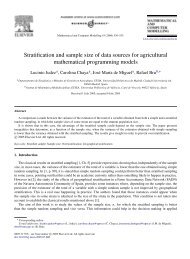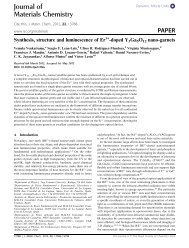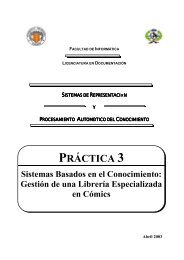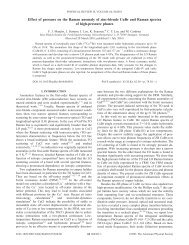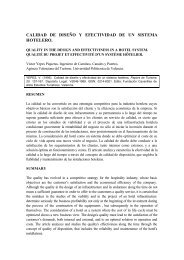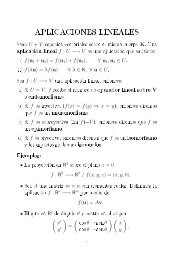Introduction to the resistivity surveying method. The resistivity of ...
Introduction to the resistivity surveying method. The resistivity of ...
Introduction to the resistivity surveying method. The resistivity of ...
Create successful ePaper yourself
Turn your PDF publications into a flip-book with our unique Google optimized e-Paper software.
3<br />
carry out <strong>the</strong> more data intensive 2-D and 3-D surveys. <strong>The</strong> second reason was <strong>the</strong> lack <strong>of</strong><br />
practical computer interpretation <strong>to</strong>ols <strong>to</strong> handle <strong>the</strong> more complex 2-D and 3-D models.<br />
However, 2-D and even 3-D electrical surveys are now practical commercial techniques with<br />
<strong>the</strong> relatively recent development <strong>of</strong> multi-electrode <strong>resistivity</strong> <strong>surveying</strong> instruments<br />
(Griffiths et al. 1990) and fast computer inversion s<strong>of</strong>tware (Loke 1994).<br />
Figure 3. <strong>The</strong> three different models used in <strong>the</strong> interpretation <strong>of</strong> <strong>resistivity</strong> measurements.<br />
Figure 4. A typical 1-D model used in <strong>the</strong> interpretation <strong>of</strong> <strong>resistivity</strong> sounding data for <strong>the</strong><br />
Wenner array.<br />
1.3 <strong>The</strong> relationship between geology and <strong>resistivity</strong><br />
Before dealing with <strong>the</strong> 2-D and 3-D <strong>resistivity</strong> surveys, we will briefly look at <strong>the</strong><br />
<strong>resistivity</strong> values <strong>of</strong> some common rocks, soils and o<strong>the</strong>r materials. Resistivity surveys give a<br />
picture <strong>of</strong> <strong>the</strong> subsurface <strong>resistivity</strong> distribution. To convert <strong>the</strong> <strong>resistivity</strong> picture in<strong>to</strong> a<br />
geological picture, some knowledge <strong>of</strong> typical <strong>resistivity</strong> values for different types <strong>of</strong><br />
subsurface materials and <strong>the</strong> geology <strong>of</strong> <strong>the</strong> area surveyed, is important.<br />
Table 1 gives <strong>the</strong> <strong>resistivity</strong> values <strong>of</strong> common rocks, soil materials and chemicals<br />
(Keller and Frischknecht 1966, Daniels and Alberty 1966). Igneous and metamorphic rocks<br />
typically have high <strong>resistivity</strong> values. <strong>The</strong> <strong>resistivity</strong> <strong>of</strong> <strong>the</strong>se rocks is greatly dependent on <strong>the</strong><br />
degree <strong>of</strong> fracturing, and <strong>the</strong> percentage <strong>of</strong> <strong>the</strong> fractures filled with ground water. Sedimentary<br />
Copyright (1999-2001) M.H.Loke


